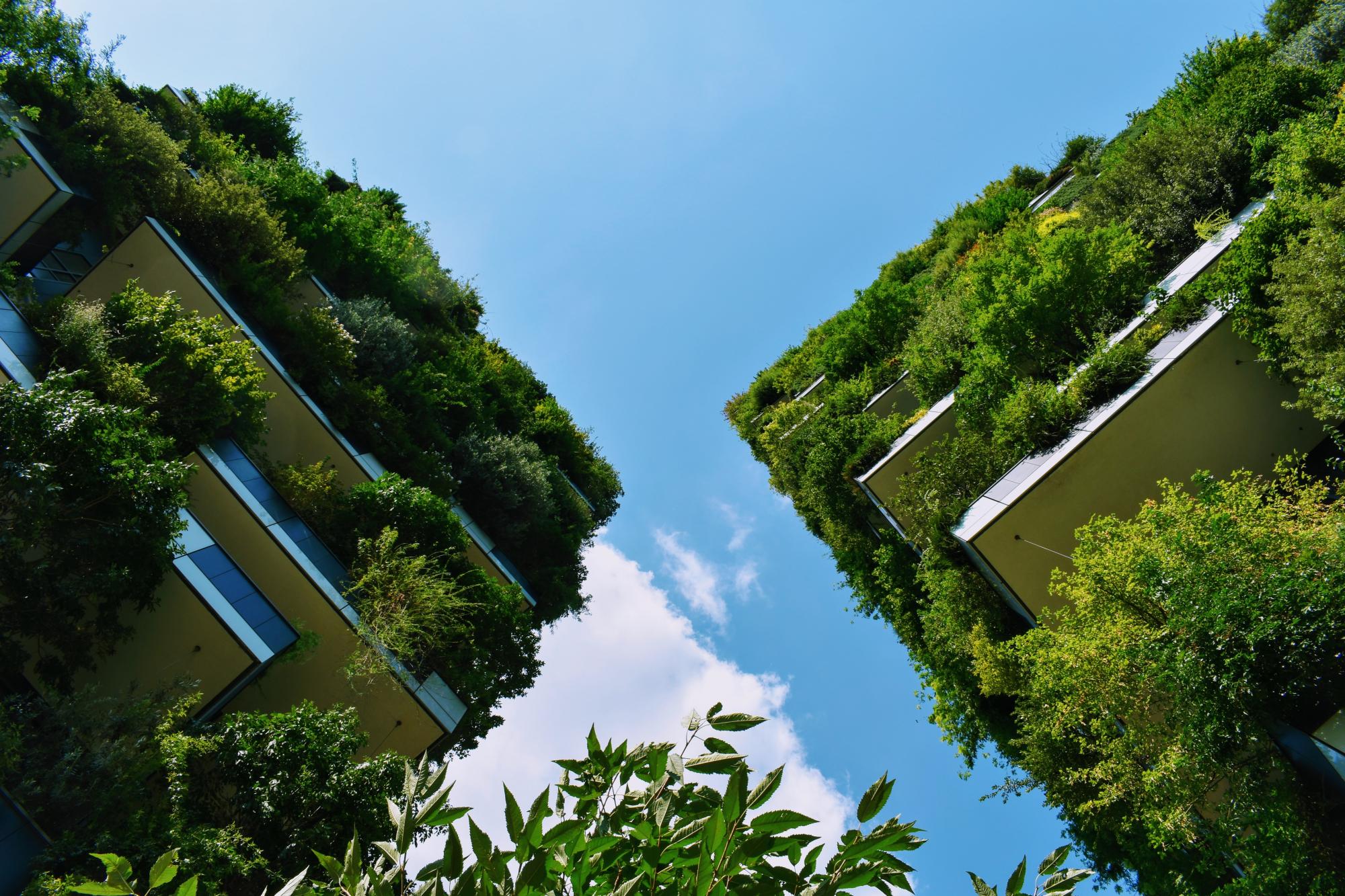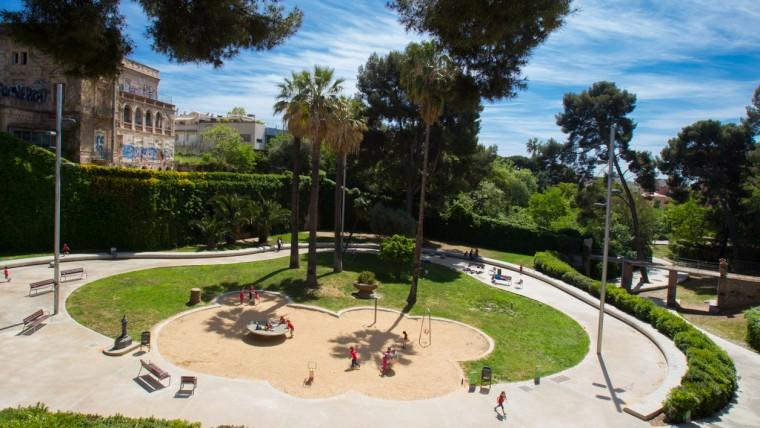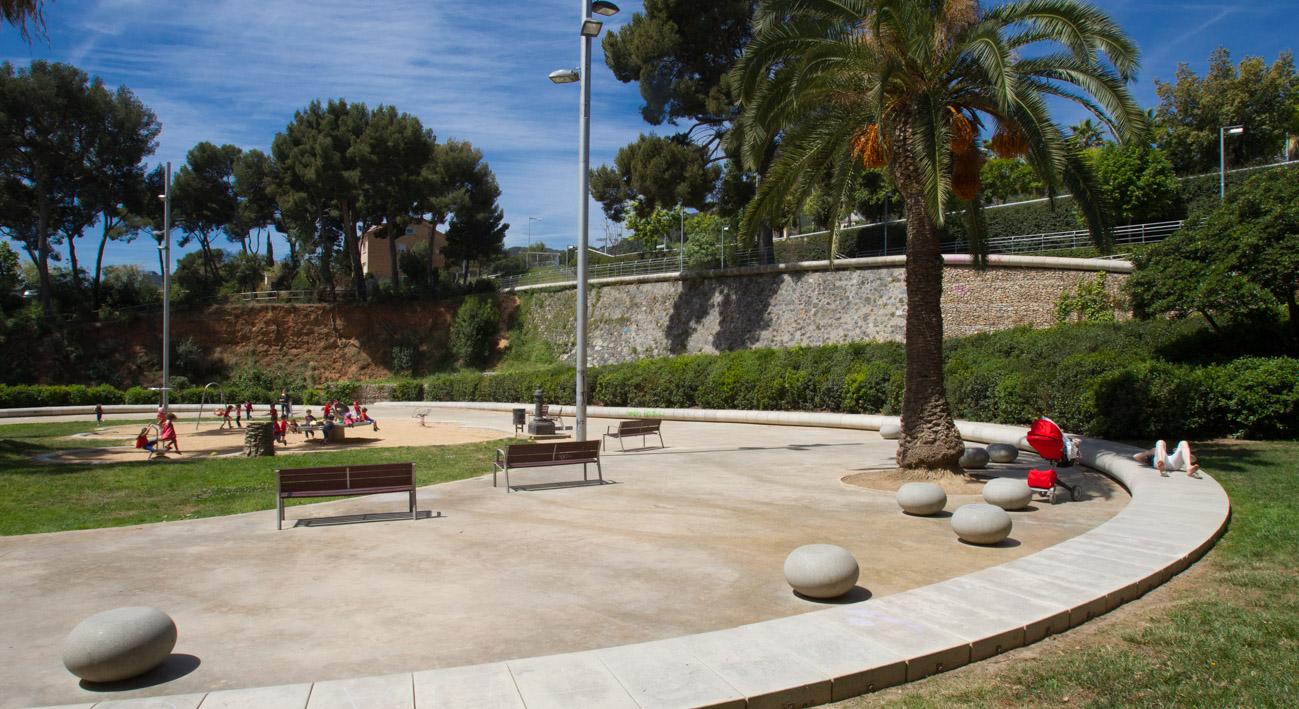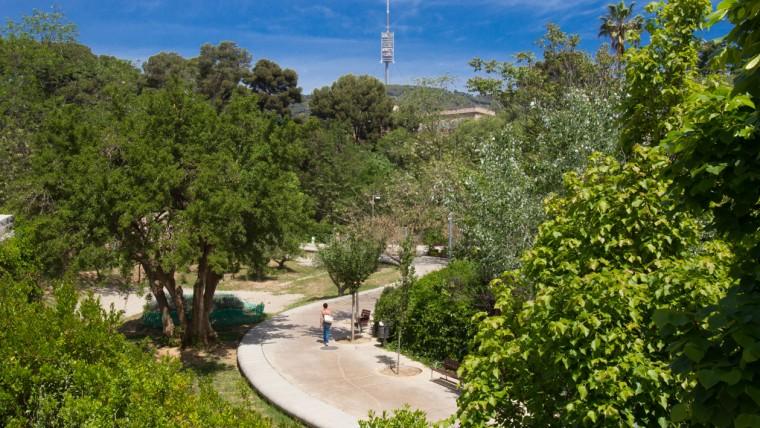Last updated: October 2021
Joan Reventós Park is a public park of about two hectares in Barcelona. It was opened in May 2009. The park is located within the catchment area of “Riera de les Monges” watercourse. For this reason, a sustainable drainage and sewer system (SUDS) was created in case of heavy rainfall, also harboring a flood area that prevents overflows (Ref. 1). This 20,091 square meter forest area has been converted into a recreational space for the local neighborhood and a playground, as well as a connecting corridor between the school zones and the center of the neighborhood (Ref. 3)
Overview
Nature-based solution
- Grey infrastructure featuring greens
- Other
- Parks and urban forests
- Pocket parks/neighbourhood green spaces
- Other
- Green areas for water management
- Sustainable urban drainage systems
Key challenges
- Water management (SDG 6)
- Flood protection
- Stormwater and rainfall management and storage
- Green space, habitats and biodiversity (SDG 15)
- Habitat and biodiversity conservation
- Green space creation and/or management
- Regeneration, land-use and urban development
- Regulation of built environment
- Conversion of former industrial areas
- Promote natural styles of landscape design for urban development
- Social justice, cohesion and equity (SDG 10)
- Environmental education
- Social interaction
- Health and well-being (SDG 3)
- Enabling opportunities for physical activity
- Improving mental health
- Improving physical health
- Creation of opportunities for recreation
Focus
Creation of new green areas, Creation of semi-natural blue areas, Maintenance and management of urban nature, Transformation of previously derelict areas
Project objectives
The space has conserved the vegetation and a drainage system has been constructed that allows to reuse the torrent water for irrigation. The councilor of Sarrià Sara Jaurrieta explained that "both the filtered water and the one of a collector that goes below is used" and it turns it over to the water table (Ref 5). Goals for the project are water absorption and filtration (Ref 1, 2 and 3).
- Bring nature closer to citizens, improving the quality of life and creating environments healthier (Ref. 7)
Implementation activities
The rearrangement has been done respecting the existing vegetation and the space generated by the torrent. Thus, priority has been given to the conservation of the natural features of the park, and also original plantations have been planted in the Sierra de Collserola, which is very close to the area of the Park (Ref 3). The system allows the collection of rainwater through different types of drainage pavement that filter water and purify it at the same time. Once filtered, the water is brought back through the subsoil and infiltrates to the ground. In case of heavy rains, it would be held in the zone of detention or in flood areas created for this purpose. (Ref 3)
- Implementation of a sustainable drainage system that allows the collection of rainwater (Ref. 3)
- Conservation of the park's natural features, and original species from the Collserola mountain range have also been planted (Ref. 3)
-This 20,091 square meter forest area has been converted into a recreational space for the local neighborhood and a playground, as well as a connecting corridor between the school zones and the center of the neighborhood (Ref. 3)
Biodiversity conservation or restoration-focused activities
Biodiversity conservation:
- Protect and enhance urban habitats
- Preserve and strengthen existing habitats and ecosystems
- Preserve and strengthen habitat connectivity
- Reduce negative impacts and avoid the alteration/damage of ecosystem
- Means for conservation governance
- Manage biological resources for conservation and sustainable use
- Raise public awareness
Main beneficiaries
- Local government/Municipality
- Public sector institution (e.g. school or hospital)
- Citizens or community groups
Governance
Management set-up
- Government-led
Type of initiating organisation
- Local government/municipality
Participatory approaches/ community involvement
- Dissemination of information and education
Details on the roles of the organisations involved in the project
The local municipality and especially the District Councillor have been promoting the project, named after a popular politician from the area who passed away in 2004 (Ref 3). The old stream of les Monges was a private space with closed access. With its recovery, this 20,091 square meter forest area has been converted into a public-access recreational urban park. (Ref. 3)
Project implemented in response to ...
... an EU policy or strategy?
Unknown
... a national policy or strategy?
Unknown
... a local policy or strategy?
Unknown
Financing
Total cost
More than €4,000,000
Source(s) of funding
- Unknown
Type of funding
- Unknown
Non-financial contribution
Unknown
Impacts and Monitoring
Environmental impacts
- Environmental quality
- Improved soil quality
- Water management and blue areas
- Improved water quality
- Increased protection against flooding
- Improved stormwater management
- Green space and habitat
- Promotion of naturalistic styles of landscape design for urban development
- Increased green space area
- Increased conservation or restoration of ecosystems
- Increased conversion of degraded land or soil
- Reduced biodiversity loss
- Restoration of derelict areas
- Other
Economic impacts
- Increased property prices
- Stimulate development in deprived areas
Socio-cultural impacts
- Social justice and cohesion
- Fair distribution of social, environmental and economic benefits of the NBS project
- Improved liveability
- Improved access to urban green space
- Increased opportunities for social interaction
- Health and wellbeing
- Improved physical health
- Improved mental health
- Gain in activities for recreation and exercise
- Cultural heritage and sense of place
- Improvement in people’s connection to nature
- Protection of natural heritage
- Increased awareness of flora and fauna as culturally and historically meaningful
- Increased appreciation for natural spaces
- Education
- Increased knowledge of locals about local nature
Type of reported impacts
Expected impacts, Achieved impacts
Presence of formal monitoring system
Unknown
Presence of indicators used in reporting
No evidence in public records
Presence of monitoring/ evaluation reports
No evidence in public records
Availability of a web-based monitoring tool
No evidence in public records
References
1. Ajuntament de Barcelona (no date). "El parque de Joan Reventós". Available at: Source link (Accessed: July 25, 2020)
2. Ajuntament de Barcelona (no date). "Parc de Joan Reventós". Available at: Source link (Accessed: July 25, 2020)
3. Ribas, C. (2009). The Joan Reventós de Sarrià park, the first with «sustainable drainage». Available at: Source link (Accessed: July 25, 2020).
4. Bonet, M. (2009). "Barcelona estrena el primer gran parc que reaprofita tota l'aigua" [Barcelona launches the first great park that reuses water]. Available at: Source link (Accessed: July 25, 2020)
5. Catalunya Radio (2009). The neighborhood of Sarrià opens the new Reventós park. Available at: Source link (Accessed: July 25, 2020)
6. Terra, Aigua i Racons (2017). "Sabéis que es el Drenaje Sostenible?". Available at: Source link (Accessed: July 25, 2020)
7. Soto, R. (2019). "Evolución de lo Sistemas Urbanos de Drenaje Sostenible en Barcelona". Available at: Source link (Accessed: July 25, 2020)
8. Vilá, J. (2018). "Parque de Joan Reventós: una zona verde diferente". Available at: Source link (Accessed: July 25, 2020)
2. Ajuntament de Barcelona (no date). "Parc de Joan Reventós". Available at: Source link (Accessed: July 25, 2020)
3. Ribas, C. (2009). The Joan Reventós de Sarrià park, the first with «sustainable drainage». Available at: Source link (Accessed: July 25, 2020).
4. Bonet, M. (2009). "Barcelona estrena el primer gran parc que reaprofita tota l'aigua" [Barcelona launches the first great park that reuses water]. Available at: Source link (Accessed: July 25, 2020)
5. Catalunya Radio (2009). The neighborhood of Sarrià opens the new Reventós park. Available at: Source link (Accessed: July 25, 2020)
6. Terra, Aigua i Racons (2017). "Sabéis que es el Drenaje Sostenible?". Available at: Source link (Accessed: July 25, 2020)
7. Soto, R. (2019). "Evolución de lo Sistemas Urbanos de Drenaje Sostenible en Barcelona". Available at: Source link (Accessed: July 25, 2020)
8. Vilá, J. (2018). "Parque de Joan Reventós: una zona verde diferente". Available at: Source link (Accessed: July 25, 2020)



